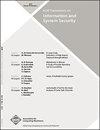检查统计攻击开口的大型击键生物识别数据集
Q Engineering
引用次数: 60
摘要
传统上,基于击键的身份验证研究假设人类冒充者通过在键盘上打字来生成伪造品。现在人们已经很清楚,机器人有能力发起精确定时的按键序列,这种攻击模式很可能低估了基于按键的系统在实践中面临的威胁。在这项工作中,我们研究了基于击键的身份验证系统在受到模仿典型用户的合成攻击时会如何执行。为了实施攻击,我们对从3000多名用户收集的2年多时间内的击键生物特征数据进行了严格的统计分析,然后使用观察到的统计特征来设计和启动针对三种最先进的基于密码的击键验证系统的算法攻击。相对于通常用于测试击键生物识别系统性能的零努力攻击,我们表明,我们的算法攻击将三种高性能击键验证器的平均相等错误率(EERs)提高了28.6%至84.4%。我们还发现,当遭受攻击的击键配置文件基于较短的字符串时,攻击的影响更为明显,并且一些用户在攻击下的性能下降要比其他用户严重得多。本文呼吁从传统的测试基于密码的击键验证器性能的零努力方法转向更严格的算法方法,以捕获当今机器人构成的威胁。本文章由计算机程序翻译,如有差异,请以英文原文为准。
Examining a Large Keystroke Biometrics Dataset for Statistical-Attack Openings
Research on keystroke-based authentication has traditionally assumed human impostors who generate forgeries by physically typing on the keyboard. With bots now well understood to have the capacity to originate precisely timed keystroke sequences, this model of attack is likely to underestimate the threat facing a keystroke-based system in practice. In this work, we investigate how a keystroke-based authentication system would perform if it were subjected to synthetic attacks designed to mimic the typical user. To implement the attacks, we perform a rigorous statistical analysis on keystroke biometrics data collected over a 2-year period from more than 3000 users, and then use the observed statistical traits to design and launch algorithmic attacks against three state-of-the-art password-based keystroke verification systems.
Relative to the zero-effort attacks typically used to test the performance of keystroke biometric systems, we show that our algorithmic attack increases the mean Equal Error Rates (EERs) of three high performance keystroke verifiers by between 28.6% and 84.4%. We also find that the impact of the attack is more pronounced when the keystroke profiles subjected to the attack are based on shorter strings, and that some users see considerably greater performance degradation under the attack than others. This article calls for a shift from the traditional zero-effort approach of testing the performance of password-based keystroke verifiers, to a more rigorous algorithmic approach that captures the threat posed by today’s bots.
求助全文
通过发布文献求助,成功后即可免费获取论文全文。
去求助
来源期刊

ACM Transactions on Information and System Security
工程技术-计算机:信息系统
CiteScore
4.50
自引率
0.00%
发文量
0
审稿时长
3.3 months
期刊介绍:
ISSEC is a scholarly, scientific journal that publishes original research papers in all areas of information and system security, including technologies, systems, applications, and policies.
 求助内容:
求助内容: 应助结果提醒方式:
应助结果提醒方式:


